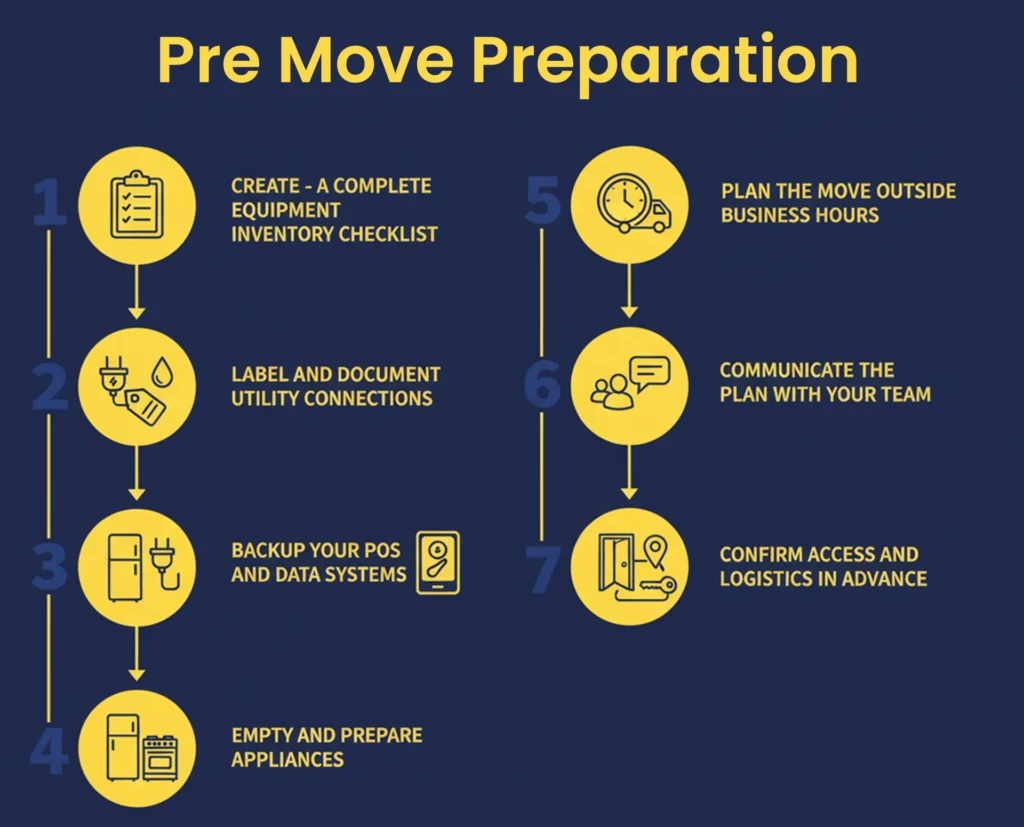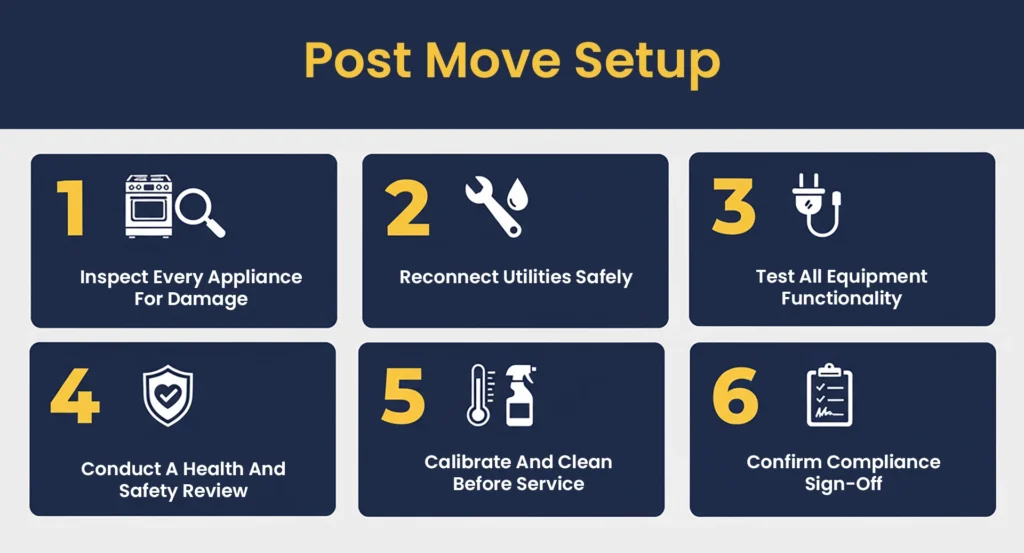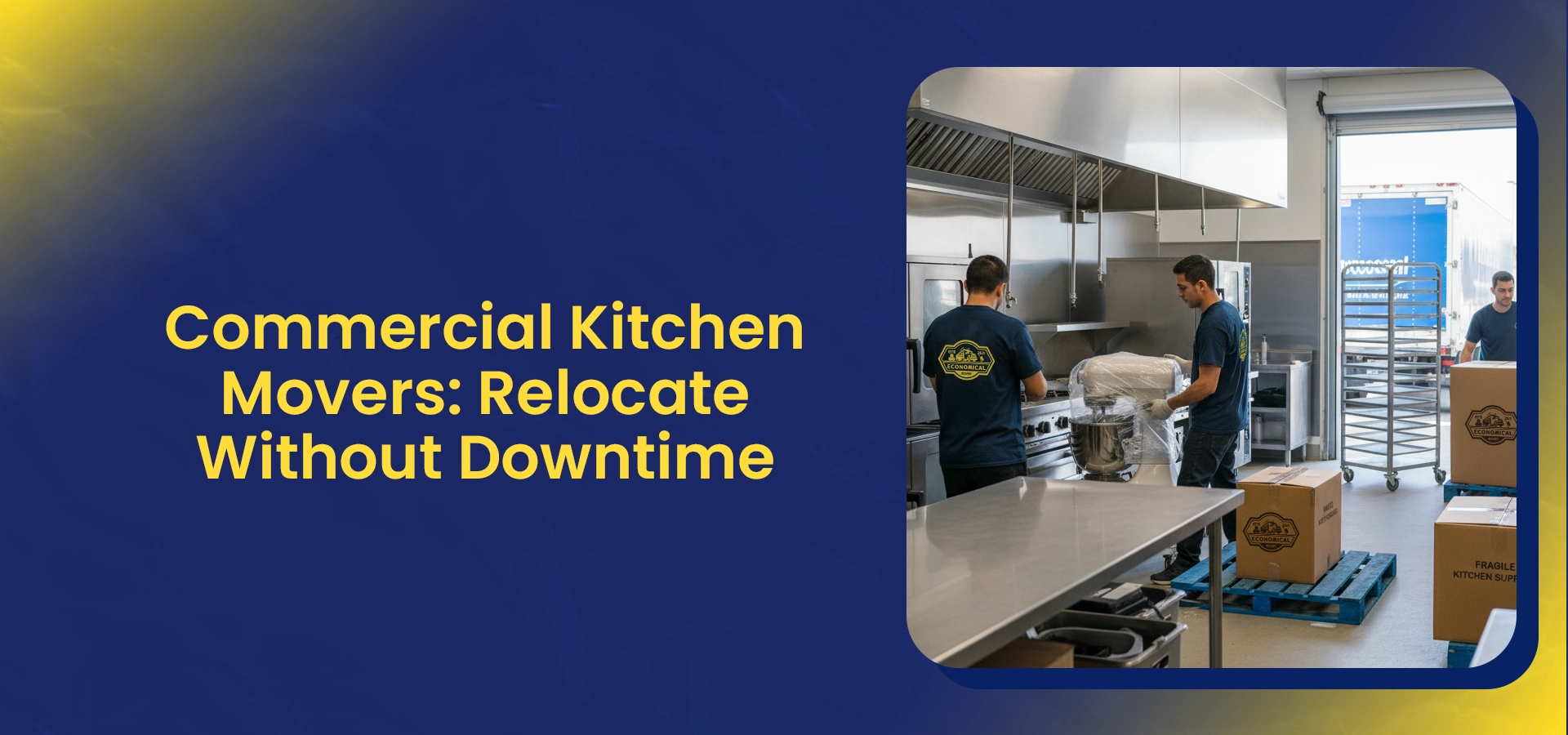Discover how experts commercial kitchen movers plan and execute restaurant relocations efficiently to reduce downtime and risk.
Imagine this🤔: it’s late evening, your restaurant is finally closed, and you’re staring at your kitchen, rows of fryers, ovens, and coolers that have served thousands of meals. Now, it all needs to move. And not just move, it has to be reinstalled, reconnected, and ready to serve again fast.
Yes, imagining this alone can make your heart sink a little.
For restaurant owners, a kitchen relocation isn’t just a move, it’s a race against downtime, lost revenue, and stressed staff. That’s why Economical Movers, comes up with a commercial kitchen moving guide that helps you to take care of every detail with precision and care.
Since 2021, we’ve completed over 1,000 commercial moves, helping businesses relocate their kitchens efficiently and safely. And here we present you with practical strategies to ensure your restaurant stays on schedule and your kitchen never skips a beat.
Why Commercial Kitchen Moves Need Smart Planning
Because moving a restaurant kitchen is a whole different game.
You’re not just relocating tables and chairs, you’re dealing with heavy, built-in, and high-value equipment that keeps your kitchen alive. Every fryer, oven, and cooler has its own gas line, water source, and power setup. Unhooking and reinstalling them safely requires planning, permits, and people who know exactly what they’re doing.
1. Equipment Isn’t Just Heavy – It’s Complicated 🧩
Commercial kitchen gear is large, fragile, and connected to gas, water, and electrical systems. A single missed step during disconnection can cause damage, leaks, or safety risks during reinstallation.
2. Downtime Costs More Than Movers Do💲
Every hour your kitchen sits idle means lost sales and wasted inventory. Smart scheduling and efficient coordination reduce downtime and get operations running again quickly.
3. Safety And Compliance Aren’t Optional 🚨
Relocating fryers, exhausts, and coolers must follow strict fire, gas, and health codes. Certified technicians ensure each connection meets regulatory standards before restarting your kitchen.
4. Building Coordination Saves Days of Delays 👥
Access hours, freight elevators, and loading docks affect timing. Coordinating early with property managers and building supervisors avoids last-minute disruptions and unexpected waiting time.
5. Think Ahead Not Just About The Move But About The Setup ⚙️
Many restaurant owners only plan the move-out day. But what happens after delivery? Where does each unit go? How will your workflow adjust? Pre-plan the layout and label every crate clearly so that everything lands exactly where it belongs, without confusion or wasted time.
6. Communication Is Your Best Tool 🗣️
The most successful moves happen when your kitchen staff and movers work as one team. Your chef knows what can’t stop working, and your movers know how to protect and transport it. We keep everyone in the loop, so your relocation feels like a coordinated kitchen rush, fast, organized, and precise.
Pre Move Preparation For Restaurant Relocation
Moving a restaurant kitchen successfully starts long before the first appliance is lifted. The key lies in preparation, communication, and timing. A well planned pre move process can mean the difference between reopening in days or being stuck in downtime for weeks. Here’s how professionals approach it.

1. Create – A Complete Equipment Inventory Checklist
Before anything is disconnected, make a detailed inventory of every appliance and fixture in your kitchen. List the large units such as ovens, grills, walk-in coolers, and dishwashers, along with smaller items like blenders, prep tables, and utensils. Tag and photograph each piece to track its condition and placement. This helps movers plan handling and ensures nothing goes missing or gets misplaced during reinstallation.
2. Label And Document Utility Connections
Every gas, water, and power connection should be clearly labelled before removal. Many kitchen delays happen because a fryer or steam oven arrives without knowing which line it connects to. Documenting connections allows the setup team to reinstall everything quickly and correctly without trial and error.
3. Backup Your POS And Data Systems
Your Point-of-Sale (POS) system, customer data, and order history are as critical as your equipment. Before moving, back up all data to secure cloud storage or an external drive. Power cuts or sudden disconnections can cause data loss, and no restaurant wants to reopen without sales records or menu settings intact.
4. Empty And Prepare Appliances
Freezers, coolers, and ovens must be cleaned, defrosted, and dried before transport. Leaving moisture or residue can cause odours and bacterial buildup. Movers also need appliances free of grease to safely wrap and transport them without damage or contamination.
5. Plan The Move Outside Business Hours
Restaurant operations cannot pause easily. That’s why experienced commercial kitchen movers schedule relocations after closing hours or on weekends. Moving when your doors are closed means less disruption, less stress for staff, and a smoother transition. Proper scheduling helps minimize lost working time and ensures business resumes quickly.
6. Communicate The Plan With Your Team
Everyone in your restaurant should know what is moving, when it’s happening, and what they are responsible for. The chef can identify priority equipment, while managers can oversee labelling and inventory. When the whole team understands the plan, the move flows efficiently, and surprises are avoided.
7. Confirm Access And Logistics In Advance
Check loading zones, elevator access, and parking arrangements before moving day. Restaurant locations often have narrow alleys, limited parking, or shared building access. Coordinating these details in advance saves time and prevents unnecessary delays once moving begins.
How Commercial Kitchen Movers Ensure A Smooth Move
When moving a restaurant kitchen, experience makes all the difference. Specialist movers use specific equipment, protective materials, and coordinated teamwork to make sure your kitchen is moved, reinstalled, and operational without unnecessary delays.
1. Specialized Packing And Crating
Commercial kitchen movers use padded crates, moisture barriers, and stainless-steel-safe covers to protect sensitive equipment. Every oven, fryer, and cooler is wrapped, secured, and labelled for safe transit, preventing dents, leaks, or electrical damage during the move.
2. Disconnection By Certified Technicians
Gas, electrical, and plumbing disconnections are handled by certified professionals. This ensures every appliance is safely shut off and capped. Proper handling prevents leaks, short circuits, or violations that could delay reopening your restaurant.
3. Safe Transport And Loading Practices
Heavy-duty dollies, liftgates, and air-ride trucks keep your equipment stable during transport. Movers secure items with straps and padding to avoid vibration or shifting, ensuring even delicate appliances arrive safely and ready for installation.
4. Precision Placement And Reinstallation
Once on-site, movers position each appliance according to your kitchen layout. Equipment is levelled, aligned, and ready for reconnection. This detailed setup reduces downtime and helps your staff resume work quickly and efficiently.
5. Coordination Between Movers and Restaurant Teams
A smooth kitchen relocation depends on communication. Movers coordinate with chefs, managers, and maintenance teams to match your workflow and setup order. This teamwork keeps everything organized and minimizes disruption to daily operations.
6. Inspection Before Completion
Before finishing the move, the team inspects all appliances for alignment, safety, and function. This quality check ensures every oven, cooler, and fryer is secure, clean, and ready to run the moment your kitchen reopens.
Post Move Setup: Getting Your Kitchen Back In Action
Once your equipment arrives, the final phase begins – testing, inspecting, and certifying your kitchen before reopening. A detailed post move checklist ensures your new workspace runs safely, efficiently, and in full compliance with local regulations.

1. Inspect Every Appliance For Damage
Before turning anything on, check for dents, leaks, or loose fittings. Confirm that fryers, ovens, and refrigerators sit level and stable. Reporting issues early helps movers or technicians address them before they affect your daily kitchen operations.
2. Reconnect Utilities Safely
Allow licensed electricians and plumbers to reconnect gas, water, and power lines. Proper connections ensure efficient operation and compliance with safety standards preventing costly shutdowns or potential fire and gas hazards later.
3. Test All Equipment Functionality
Run each unit through a full cycle to confirm performance. Test burners, ovens, dishwashers, and refrigeration systems to ensure proper heating, cooling, and drainage. Early testing allows time to fix issues before reopening to the public.
4. Conduct A Health And Safety Review
Before service resumes, schedule an internal inspection. Check ventilation, grease traps, and sanitation systems. Addressing small concerns now prevents fines or delays during official health inspections after reopening.
5. Calibrate And Clean Before Service
Recalibrate thermostats, timers, and digital controls to manufacturer settings. Deep clean all surfaces, handles, and cooking stations. A spotless and well-tuned kitchen ensures top performance and maintains your brand’s hygiene standards from day one.
6. Confirm Compliance Sign-Off
Before reopening, confirm all installation and inspection reports are signed by certified professionals or local authorities. Keeping these documents ready ensures your business passes future inspections smoothly and avoids any operational interruptions.
Final Thoughts Commercial Kitchen Moving
Relocating a commercial kitchen takes more than muscle it demands planning, coordination, and technical know-how. From managing gas lines to reinstalling refrigeration units, every step must follow safety and compliance standards. Working with experienced movers can make this process organized and efficient, helping your team return to normal operations quickly. Economical Movers applies years of industry experience and a clear understanding of restaurant logistics to handle these complex moves with precision. With careful preparation and the right support, your new kitchen can be up and running smoothly, ready to serve customers again without unnecessary delays.
Frequently Asked Questions About Commercial Kitchen Moves
Q.1) How Do You Move A Commercial Kitchen Efficiently?
Answer: An efficient commercial kitchen move starts with a detailed plan. It begins with creating a complete equipment inventory, disconnecting appliances safely, and packing everything with specialized materials. The team coordinates with restaurant staff and utility professionals to ensure every piece of equipment is reinstalled and operational quickly, minimizing downtime.
Q.2) How Long Does It Take To Relocate A Restaurant Kitchen?
Answer: The duration depends on your kitchen’s size and the complexity of your setup. Small cafés can often move overnight, while full-scale restaurants may require one to three days. Moves are usually scheduled during off-hours or weekends to reduce lost business time and get the kitchen back in action fast.
Q.3) Do I Need Special Permits To Move Commercial Kitchen Equipment?
Answer: Yes, many cities require permits when relocating gas lines, exhaust systems, or heavy appliances. Professional movers handle all necessary coordination with local building and health authorities to ensure your move meets safety, ventilation, and code compliance requirements.
Q.4) How Should I Prepare My Restaurant For A Kitchen Move?
Answer: Preparation includes cleaning and labelling all equipment, backing up POS and digital records, and clearing storage areas. A detailed equipment checklist and move schedule can help minimize operational disruption and keep everything organized.
Q.5) What Makes Economical Movers A Different Commercial Kitchen Moving Company?
Answer: Our focus is on precision, compliance, and continuity. Economical Movers combines years of experience in restaurant relocations with certified handling, insured services, and seamless coordination. We’re not just movers, we’re relocation partners who keep your business running smoothly through every stage of the move.
Q.6) How Much Does Commercial Kitchen Move In Ontario?
Answer: Costs vary based on the kitchen size, distance, and number of appliances. On average, commercial kitchen moves in Ontario range between $2,500 and $8,000. Economical Movers provides transparent quotes with no hidden fees, so you know exactly what to expect before moving day.
Q.7) Can I Move My Restaurant Kitchen During Business Hours?
Answer: While possible, it’s not recommended. To avoid customer disruption, many moving companies offer flexible scheduling, including overnight and weekend moves, so your business can continue operating smoothly without closing its doors.



